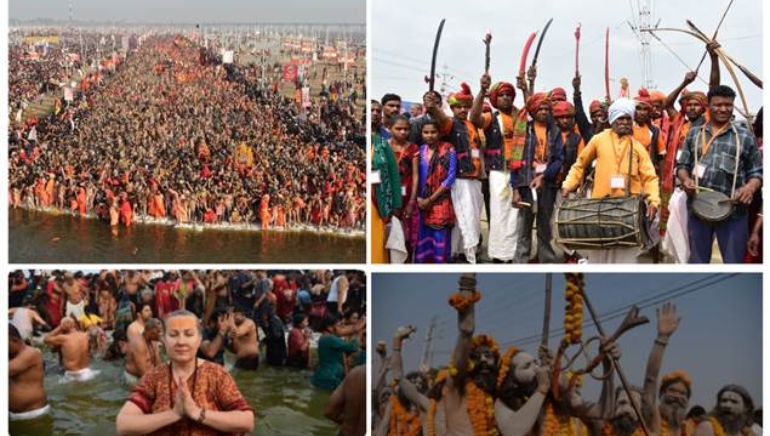Indians Gather for Maha Kumbh Mela 2023: The World’s Largest Religious Gathering
In a magnificent display of faith and devotion, millions of Hindu devotees, mystics, and holy figures assembled in the northern city of Prayagraj on Monday to inaugurate the Maha Kumbh Mela. This festival, celebrated every twelve years, is renowned as the world’s largest religious gathering, drawing participants from every corner of India and beyond.
The Sacred Confluence
Over the next six weeks, Hindu pilgrims will journey to the revered confluence of three sacred rivers — the Ganges, Yamuna, and the mythical Saraswati. At this spiritual crossroads, pilgrims will engage in a series of intricate rituals, including bathing in the holy waters, with the aspiration to attain liberation from the relentless cycle of birth and rebirth that defines Hindu philosophy.
Rituals of Purification
For Hindus, rivers hold profound spiritual significance, especially the Ganges and Yamuna. Devotees believe that a bath in these waters can cleanse them of past sins and facilitate their escape from the cycle of reincarnation, an aim that resonates particularly during auspicious days of the festival. The Maha Kumbh Mela is steeped in centuries-old tradition, featuring ritualistic baths performed by both sadhus (holy men) and millions of devotees. The legend narrates how the Saraswati River, which is believed to have flowed from the Himalayas, joins the Ganges and Yamuna at Prayagraj.
On specially designated days, often at dawn, ash-smeared and sometimes unclothed monks dive into the rivers, while pilgrims undertake their own bathing rituals. Many practice austerity, donate to charity, and seek spiritual solace during this transformative time. “We feel peaceful here and attain salvation from the cycles of life and death,” shared Bhagwat Prasad Tiwari, a devoted pilgrim.
Mythological Roots
The origins of the Kumbh Mela find their foundation in Hindu mythology. It is said that the god Vishnu wrested a golden pitcher (or “kumbh”) containing nectar of immortality from demons. According to legend, droplets of this divine nectar fell at four locations — Prayagraj, Nasik, Ujjain, and Haridwar — which subsequently became the designated sites for the Kumbh festival. The event rotates among these four cities every three years based on meticulous astrological calculations. This year, Prayagraj is set to host the grandest iteration yet, following the Ardh Kumbh held in 2019, which recorded 240 million visitors, peaking with 50 million on its busiest day.
Logistical Marvel of Maha Kumbh 2023
As the Maha Kumbh Mela unfolds, it is projected to attract over 400 million visitors within a span of 45 days, surpassing the entire population of the United States and significantly dwarfing the number of pilgrims who attended the Hajj in Mecca and Medina last year.
Organizing such a colossal event poses an extraordinary logistical challenge for Indian authorities. A temporary city has been meticulously constructed along the riverbanks, sprawling over 15 square miles and divided into 25 sections. This makeshift infrastructure is richly equipped with over 3,000 kitchens, 150,000 restrooms, housing facilities, communication towers, and 11 hospitals, reflecting the scale and scope necessary to cater to the vast throngs of visitors. Murals depicting Hindu mythology adorn the city walls, further enhancing the cultural immersion of attendees.
To accommodate the influx of pilgrims, Indian Railways has launched over 90 special trains, facilitating nearly 3,300 trips during the festival’s duration. On the security front, authorities have deployed a robust team of 50,000 personnel — a 50% increase since the last major festival in 2019 — to ensure safety and order. More than 2,500 cameras, some equipped with AI technology, have been installed to monitor crowd dynamics and prevent risks such as stampedes. These systems feed into four central control rooms, where officials will proactively manage crowd density and maintain a secure environment for all.
Political and Cultural Dimensions
The significance of the Kumbh festival extends beyond spirituality; it also represents a cultural and political showcase that has gained newfound prominence in recent years. India’s political leaders have historically used the Kumbh as a platform to engage with the nation’s Hindu majority, which comprises nearly 80% of India’s 1.4 billion population. Under Prime Minister Narendra Modi, the Kumbh Mela has been amplified as a vehicle of Hindu nationalism, intertwining beliefs and Indian identity.
Coupled with this year’s festivities, the Uttar Pradesh state government, led by Yogi Adityanath, a fervent politician with strong ties to Modi’s Bharatiya Janata Party (BJP), allocated over 5 million for the event. The Kumbh Mela thus becomes not just a spiritual assembly but also a branding opportunity for both Adityanath and Modi. Billboards, posters, and murals depicting their images alongside government welfare slogans proliferate throughout the temporary city. Observers suggest this is part of a larger strategy aimed at solidifying the BJP’s appeal among its Hindu support base.
Controversies and Challenges Ahead
While the Maha Kumbh Mela epitomizes devotion, it has also been a magnet for political and social debates, particularly regarding the tightrope that leaders walk between fostering communal unity and furthering exclusivity. Ahead of the smaller 2019 iterations, discussions surrounding the festival touched upon critical issues like social disparities and environmental implications, as the massive crowds pose a threat to the delicate ecosystem of the rivers.
Conclusion: A Festival Beyond Faith
The Maha Kumbh Mela 2023 enhances not only the spiritual landscape of India but also its socio-political narrative. As millions converge upon Prayagraj to immerse themselves in both the waters and the vibrant culture surrounding the festival, they bring with them hopes of spiritual rejuvenation, while simultaneously participating in a complex interplay of faith, politics, and community. This congregation — whether viewed through the lens of devotion or political ambition — remains one of the most remarkable displays of human gathering, solidarity, and aspiration.
